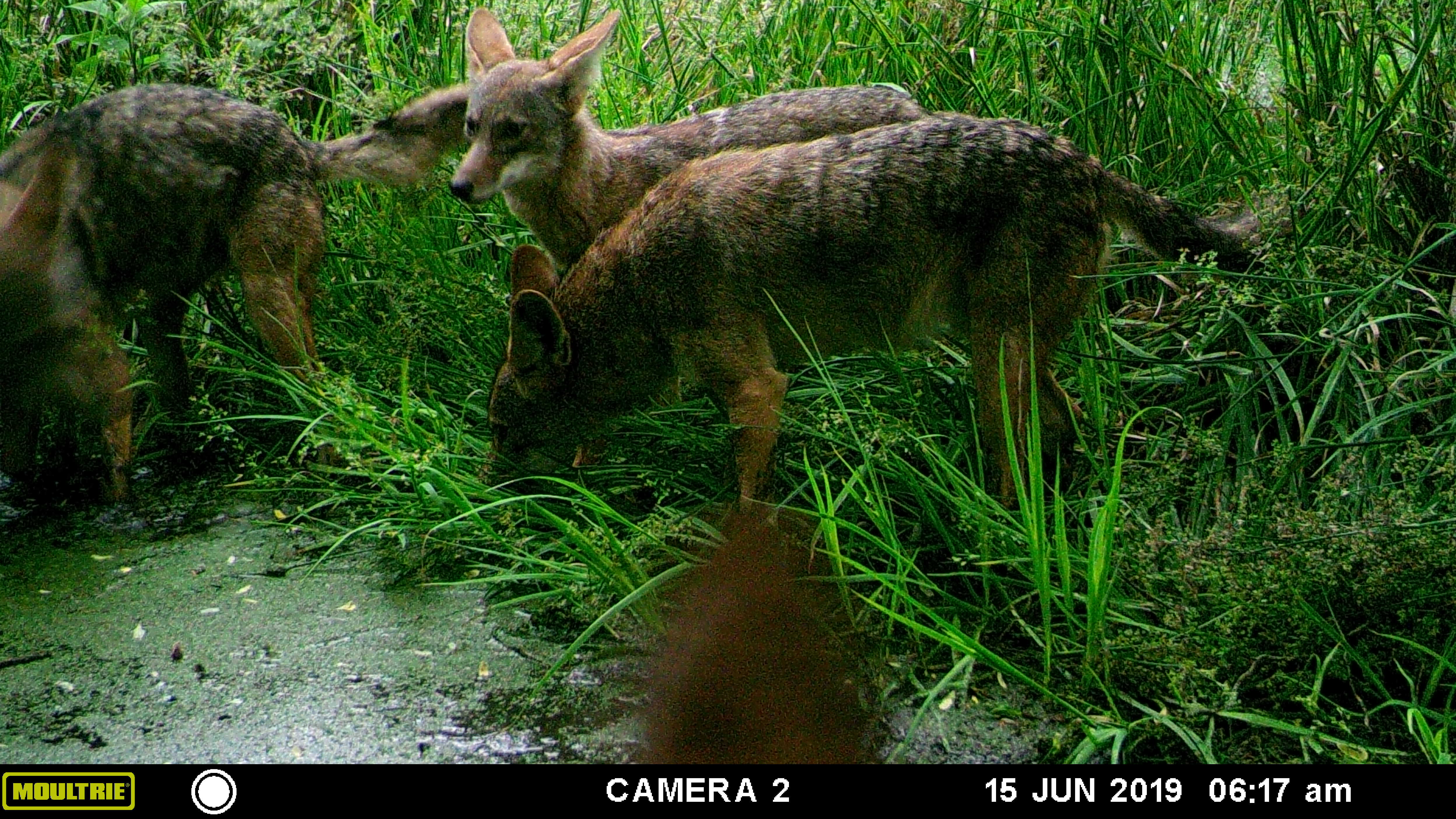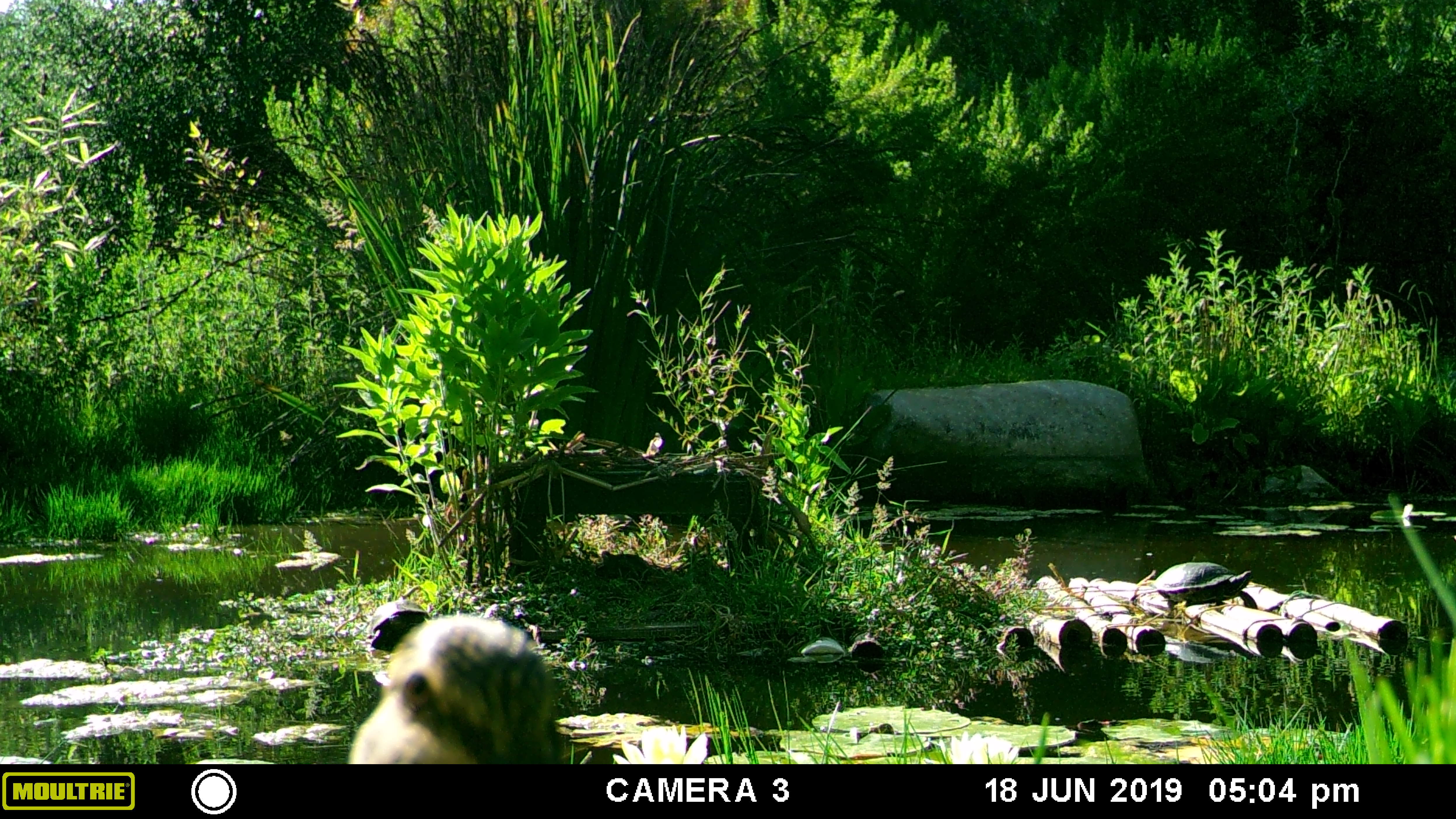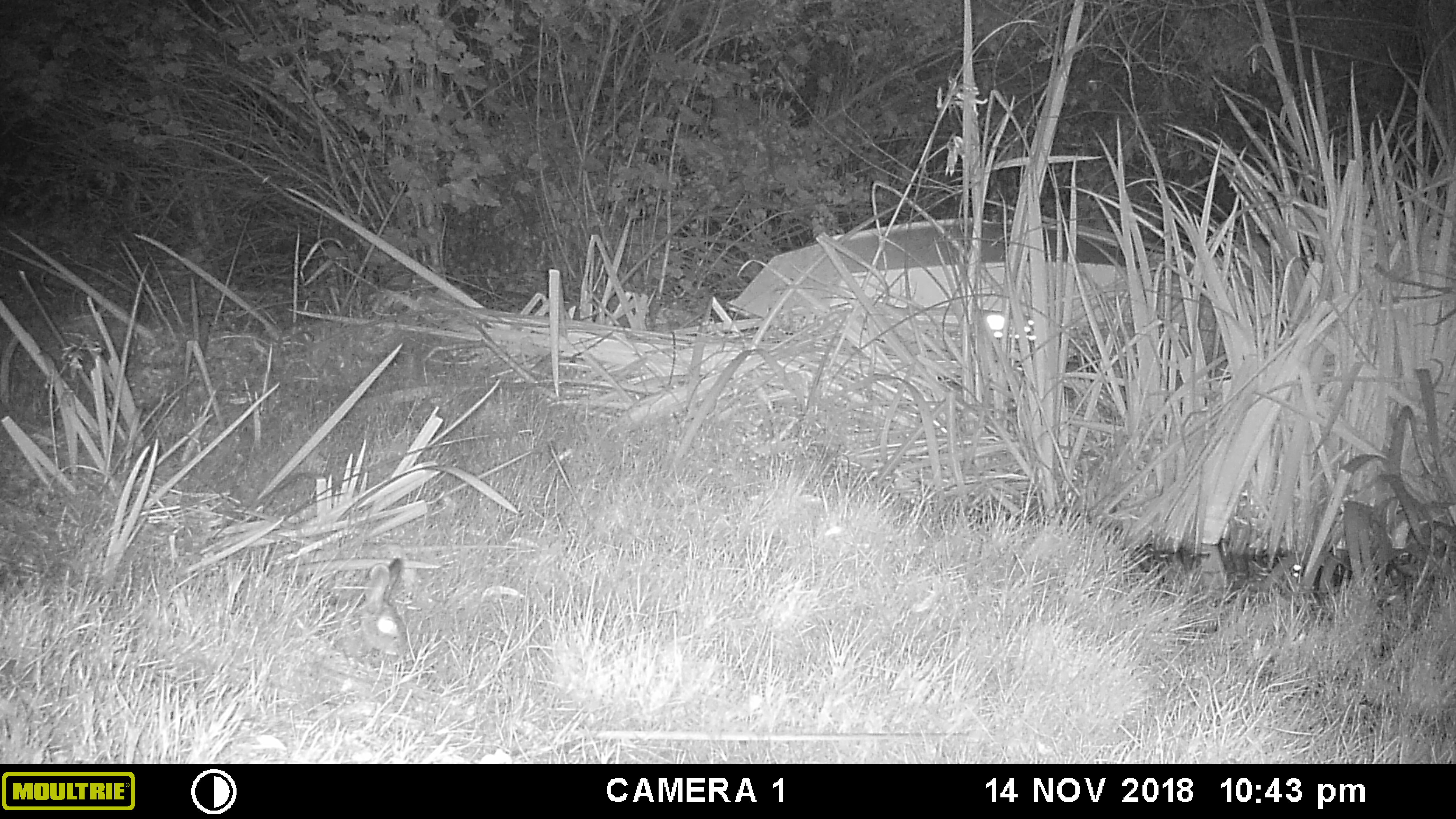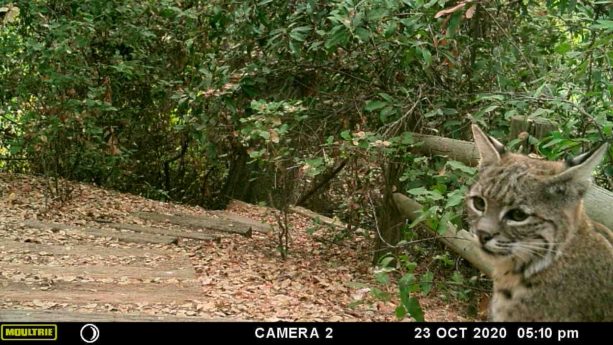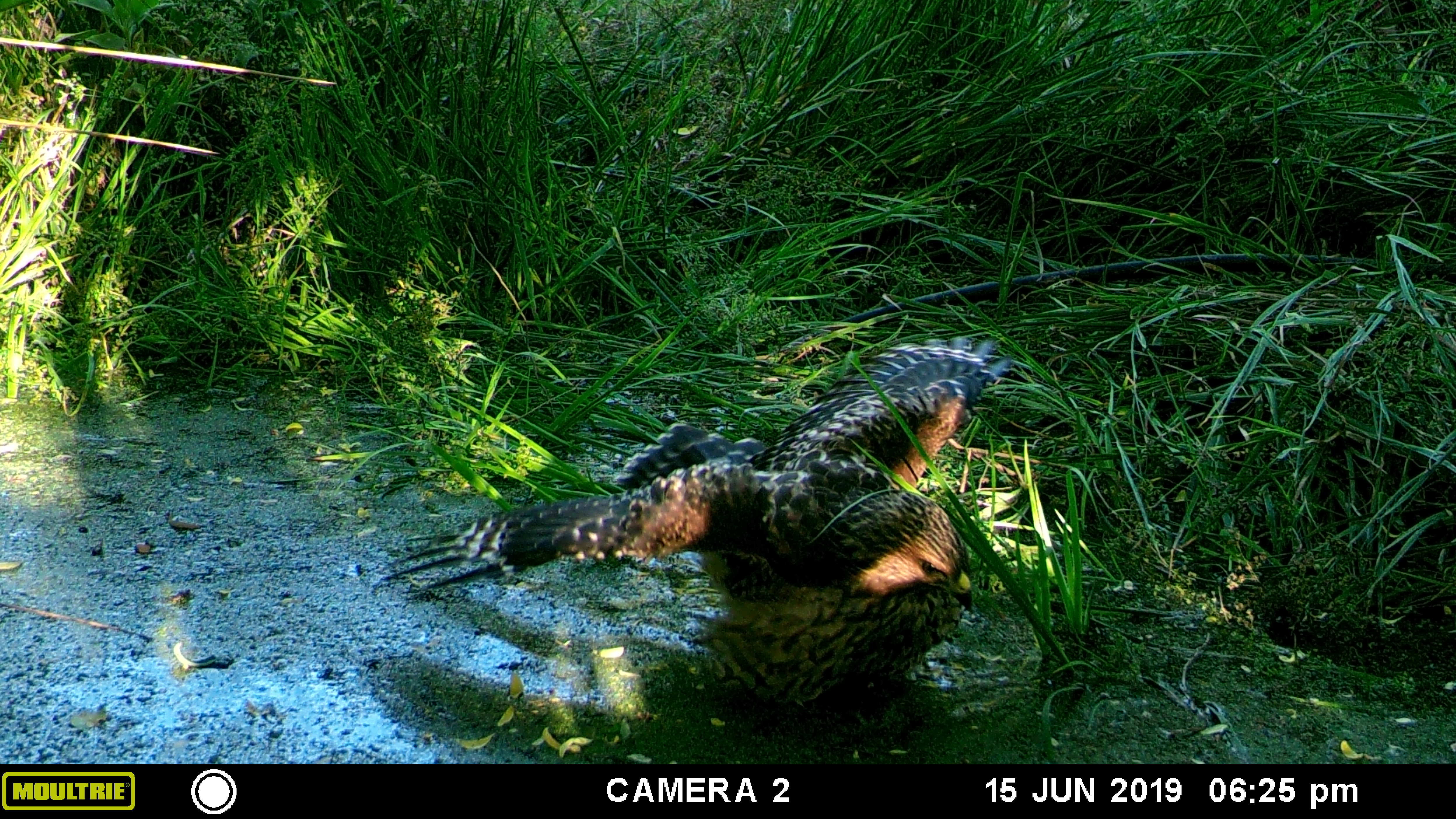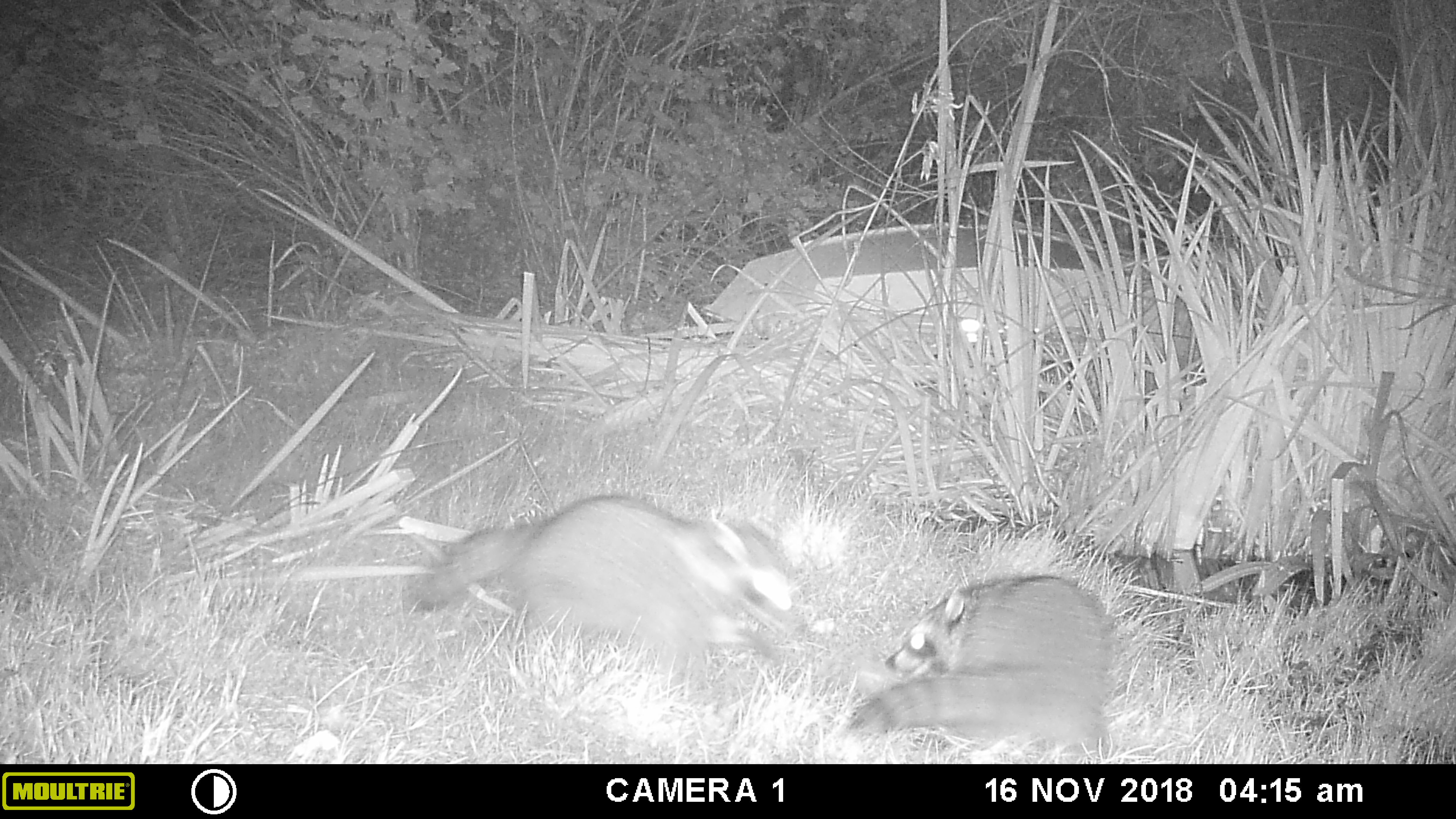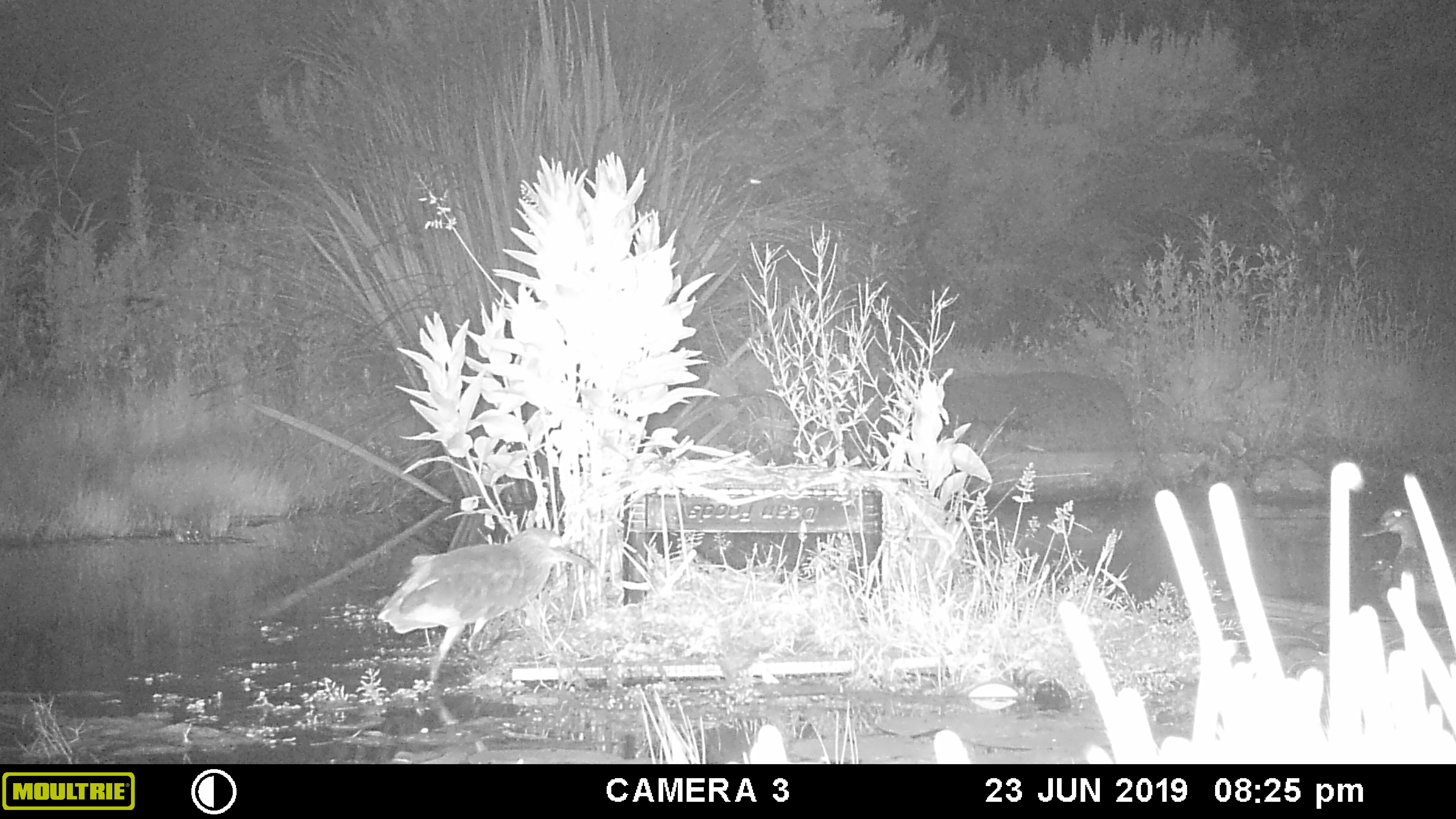-
Retired
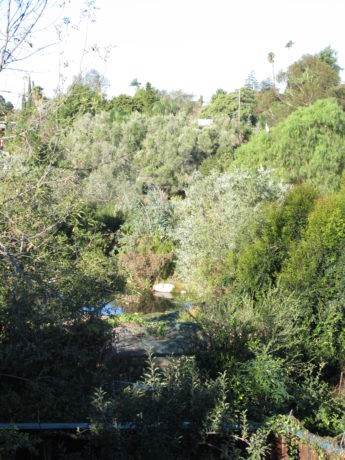
Finch Frolic Garden is now closed, and I am as of yesterday, retired. I became Diane Beeler in November, and next year we will be moving out of state. It is difficult to leave my friends, many of whom are also clients. Since the food forest was created in 2011, my daughter Miranda and I have educated thousands of visitors on our tours, in our workshops, and in off-site lectures. My heartfelt thank you to everyone who has supported us, and who has taken permaculture to heart and to practice.
I will publish when we put Finch Frolic up for sale; many of you have already expressed interest in the property.
I have been requested to keep this blog up for its information, and I will do so. I may be able to add to it when the dust settles, or create another one in our new home.
Permaculture will always be something that I practice, I preach, and I beseech homeowners to follow. Regenerative practices are vital in our stressed world.
Thank you again, friends, followers, permaculturalists, and all who donated time and money to keep us going. It was worth it.
Diane
-
Erosion Control and Planting Water
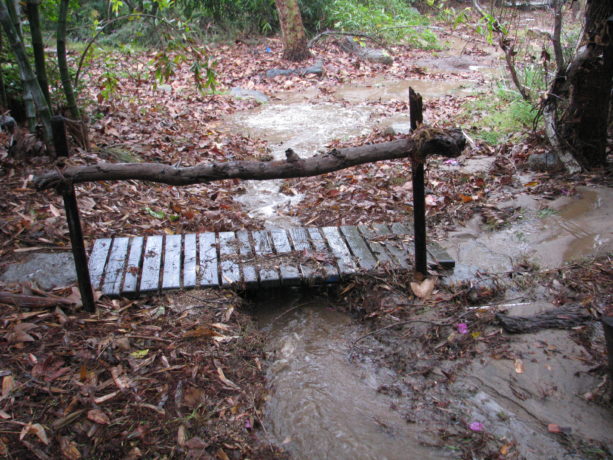
Water flowing in from the street at Finch Frolic Garden Permaculture. All water is sunk on site through a series of rain catchment basins. That equals hundreds of thousands of gallons of water even during dry years. Whether you live in a drought area as I do in Southern California, or an area that floods, proper management of water is essential. Sinking water safely and effectively involves digging swales (level bottomed ditches), and/or rain catchment basins, or dry but functional steambeds that sink water rather than expel it, or even just mulch-filled pits. Most can be done with a shovel. One inch of rain on an acre in one hour is 27,154 gallons of pure, slightly acidic water. Rainwater is a far better source for watering plants than chemical-laden domestic water, or mineral-heavy well water.
Here is a Powerpoint lecture I gave for the Fallbrook Climate Action Committee last month, which shows you the basics of erosion control and water sinkage. It also goes into using one-rock dams, media lunas, and Zuni bowls (such exotic names for such simple and common sense structures!) to heal erosion cuts. These can be done on even small erosion cuts.
Now is the time to sink water rather than have it drain into the streets. The hardscapes expelling water through drains is what causes most street flooding, as the natural plant and leaf-covered soil is no longer there to soak it up, and the vegetation is greatly reduced so that the water isn’t held in place through vascular systems. If every property safely sank and captured rainwater, everything would benefit. It isn’t difficult to do.
On the Resources page of this blog, under Finch Frolic Garden YouTube channel, I’ve bookmarked many experts showing water harvesting, sinking and control. Give yourself a little time to watch and be inspired.
-
Protect Your Plants Without Using Poison
There are simple methods to keeping your plants, food and house safe from rodents without using poison. When you poison a rodent, there is always secondary kill of a predator. That kill is often long and painful. (See my blogpost on mange https://www.vegetariat.com/2022/07/mange-rodenticide-and-a-bobcat-named-daisy/.) Here are multiple ways of keeping animals and insects away from your food and home:
Get rid of debris piles that harbor unwanted critters. This doesn’t mean getting rid of all habitat, just those areas where you see undesirable (to you) animal activity. I see the perfect squirrel palace at half of my consultations in groves: fruit trees spaced apart with no other foliage around, and a pile of cut logs in an open space. You couldn’t build a better squirrel hotel. They burrow under the logs, sit on top to watch for predators, and have open visual lines to the fruit trees. Bury the wood (it fertilizes the ground, sequesters carbon, and holds water https://www.vegetariat.com/2013/02/hugelkultur-irrigating-wood/), and interplant with fragrant low-water-use herbs such as rosemary, sage, oregano and marjoram (don’t plant directly under tropicals or subtropicals because they have shallow roots. Plant outside the dripline. You can plant under stone fruit and apples). The squirrels won’t have a home base, there will be foliage to deter their raids, and these herbs will also attract beneficial native insects to pollinate and eat the bad bugs (Integrated Pest Management) in your grove.
Squirrels decimate your fruit and nut trees? Surround your fruit trees when the fruit is ripe with a temporary boundary of any material that can’t be seen through such as old sheets, sunshade, tarps, canvas and old plastic. It can be 3’ – 4’ tall, with rocks on the bottom of the fabric so there are no gaps. Squirrels want to see where they are going, and also can’t climb the loose fabric. If there is a chance that squirrels can jump from another surface, then make the partition higher. This works very well. I’ve protected an apricot tree that was being decimated by squirrels, both the leaves and fruit, and after the barrier went up all damage stopped. There was an excellent harvest of apricots. Worked the same for some of my plum trees. The barrier can come down after the fruit harvest. Most damage is done in the spring when animals are needing more food for nesting, and when there are hungry young around. Live-trapping and relocating animals is illegal, cruel to the animal, and can transfer diseases to other wild populations. Live trapping and releasing only makes humans feel better. Releasing a scared animal away from its territory, where it doesn’t know the predators, has no home or food cache to run to, has no known water supply, and may be set up on by others of its kind, is cruel. I used to do it until I realized how bad it was. A quick, painless, poison-free death only when absolutely necessary is best.
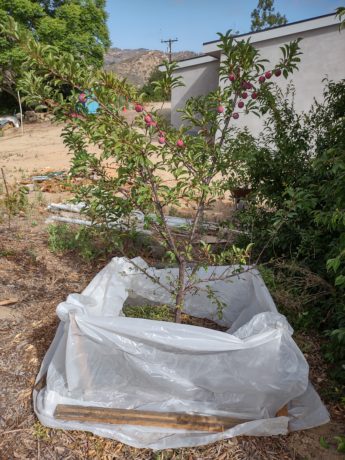
Any old plastic will do. This is the lowest you should stake the barrier; up to four feet high or more works fine. 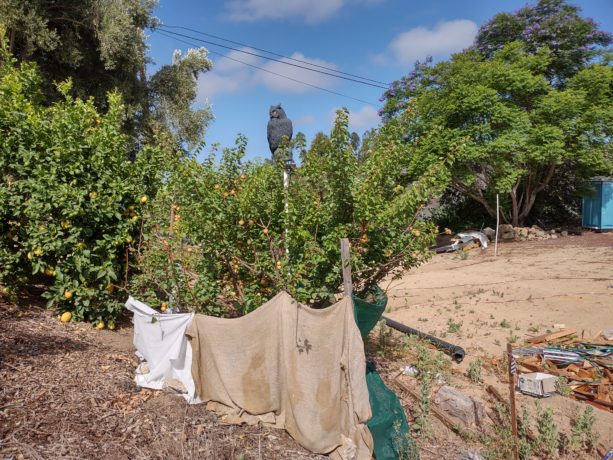
I refuse to buy plastic, so anything at hand will work. Here I used old burlap, shade cloth and frost netting wired to 2x4s around this apricot tree. Unlovely, but I used what we had. Notice the plastic owl on a pole to discourage birds. Birds will be put off by staking one of those plastic owls on a tall post right next to your fruit tree (see above photo). Repurposing old CDs and DVDs by tying them on the branches is far better than buying mylar strips which will pollute as they shred. CDs move and flash in the wind, and will also help repel deer and squirrels. These methods WORK. I’ve used them; I’m not just repeating other advice. The owl protected an apple tree from birds completely. I allow 10% of a crop to birds, and after that, up goes the owl.
Rabbits won’t jump high, so a temporary 2’ wire fence around new plantings will keep the bunnies out. When plants are larger they are more resistant to rabbits. You may need to erect a short fence all around your garden rather than individual plants. Some plants are not as yummy to rabbits, but during drought years animals are very hungry and will eat whatever they can to stay alive. Remember this when there are animals in your yard. They live there. They should be there to balance the ecology. Plant and protect accordingly.
Gophers: Surround the root ball of your new plants and trees with wire gopher baskets. Use sturdier hardware cloth for shallow-rooted plants and shrubs, and ½” or ¼” diameter chicken wire around tree roots; older roots can push through the rotting wire. Gophers need to clean their tunnels, so mulching mulch heavily or laying cardboard on the weeds with thick mulch over it (sheet mulching) deters them. When I’ve had particularly nasty gopher problems, I’ve used a Gopher Gasser down the hole closest to the plants. This can kill the gopher quickly underground with little suffering, and it won’t poison anything that may eat it. Or it may just deter the gopher from tunneling around that plant. It works.
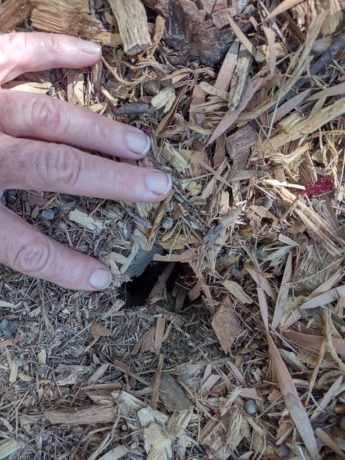
Mulch falls into gopher holes… and they don’t like it. They like sheet mulching (a layer of cardboard topped with mulch) even less. The rats that are a nuisance, mostly Norway and black rats here, are imported by humans and nest anywhere; the native rat won’t eat your plants and lives in brush piles in wooded areas so please let them be. Giving imported rats and mice a quick, humane death (it’s not their fault they are here, its ours!) is best. Use snap traps, and put them along perimeters where they like to run. Cover the traps with milk crates or something to prevent other animals from being injured in them. Peanut butter, cat or dog food, old cooking oil, and peanuts are all reliable baits. Dead unpoisoned rats and mice can be left out to attract predators such as hawks, and they will deal with far more rodents than any poison will.
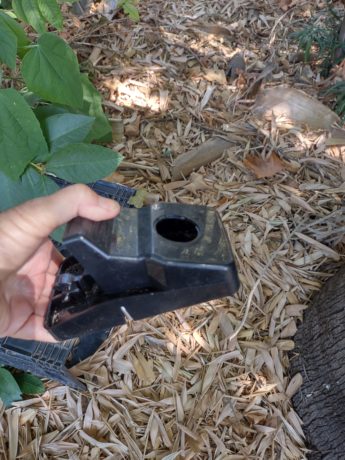
I find these are easier and safer for my fingers than the Victor ones. These are easy to set and clean, and gets the rat right behind the head for a fast kill. 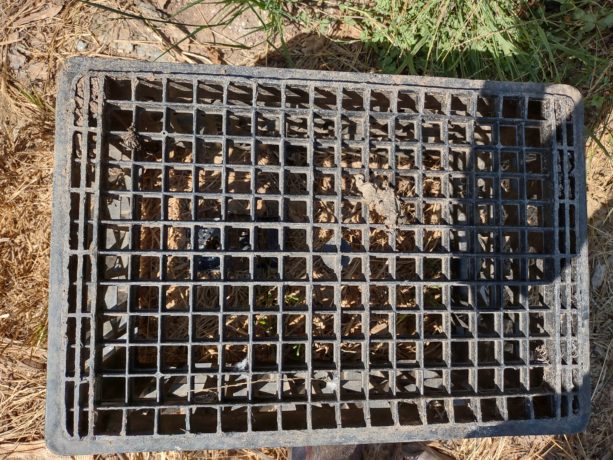
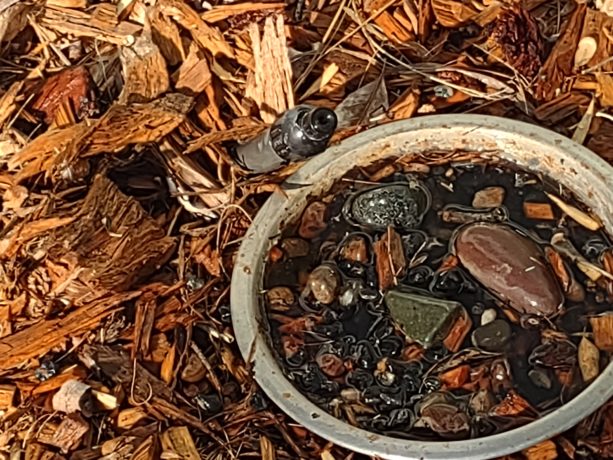
Set up watering stations by your irrigation so that animals can get a drink… away from your house. A pie pan with a rock in it works fine. Snakes seek water and warm-blooded animals to eat. If you have bird feeders next to your house, the fallen seed will attract mice and rats, and they will attract snakes. Pans of water set out in your landscape will help provide water, and piles of rocks will provide shade. Remember that snakes are essential for rodent control, and they will die eating a poisoned animals. If you have a fenced area, put snake barrier (wire netting) around the base of the fence and down into the ground. This also keeps bunnies out.
Insects: only a very small percentage of insects are considered ‘harmful’ to humans or crops. Did you know that most species of mosquito only eat pollen, so are pollinators? Yet we don’t want to be bitten and we don’t want our crops decimated, and we don’t want ants in our food. Before you whip out the broad spectrum insecticide – INCLUDING ONES MADE FROM PLANTS – identify the species that you are killing. If you see some bugs on your plant it doesn’t mean that they are killing the plant. With leaf miners you see the damage after the young have tunneled out of the citrus leaves so spraying only kills the beneficial insects, many of which are very small so you hardly see them. Orange oleander aphids on your milkweed? Leave them alone; they aren’t really harming anything. It shows that your milkweed hasn’t been treated with systemic insecticide and won’t poison Monarch butterfly caterpillars. Many of the larvae you see are those of moths and butterflies. If you have a large outbreak of one kind of bug, wait a few days to see if something comes along to eat them. Then usually a strong stream of water will knock them off the plants. If you have to use something stronger, mix a tablespoon or two of mild soap like Dr. Bronners into water and spray that only on the target pest. Check in a week or so to see if you need to reapply. Ladybug larvae look scary. Lacewings set their eggs on thin stalks so ants won’t eat them. Praying mantis egg sacs look like a lumpy growth. Be sure you know what you are attacking. The best method of insect control is to plant a variety of flowering native plants around your garden, keep healthy, mulched soil, don’t overwater, and don’t spray chemicals. Argentine ants are invaders that do a lot of ecological damage and are the ones in your house and farming aphids on your trees. Use bait traps for them (here is a post about them and a recipe for a bait solution: https://www.vegetariat.com/?s=argentine+ants). Having a poison control company spray all around your house may keep you relatively bug-free, but those chemicals can cause convulsions in animals. If you have a dog or cat that will walk over that spray, which is made to last a long time, that animal will lick its paws and can become severely ill. Same with humans who breathe that poison. Using food-grade diatomaceous earth as a barrier works well without poisoning you and your pets.
Deer are rare and beautiful here, and they need to eat green leaves for nutrition. If those leaves belong to your plants or trees, you may not want them close to your house. Design your garden with deer fencing in mind. If fencing is out, then understand that deer don’t like strong smells, sudden movements nor uneven surfaces. Placing rocks (NOT gravel) in a ring out from the dripline of your trees, laying wire mesh on the ground, using those DVDs or CDs tied from the trees, spraying with garlic and hot pepper water, have motion detector lights… all of these are ways to keep them off of your trees and plants without harming them.
Please never use poison. Our wildlife is disappearing rapidly. From 1970 to 2010 the World Wildlife Fund reported that 52% of ALL wildlife on the planet was gone. Over half the population. That percentage has grown in the last twelve years. The whole planet is an epicenter of extinction now, not just certain areas. If you stop using poisons and stop killing native animals and insects, and provide habitat instead, you will have a balanced ecosystem and a haven for the wildlife. If they go, we go.
-
Mange, Rodenticide and a Bobcat named Daisy
Bobcats are beautiful, shy animals larger than a domestic cat and much smaller than a cougar. Their main food is rabbit, mice, rats and squirrels; given the opportunity they will eat pets and hens if people are careless and unkind enough to allow their pets and hens roam. One bobcat can eat hundreds of rodents a week. They are not aggressive to humans and would rather not encounter anyone, including other bobcats unless it is mating season.
Our property is 1.6 acres, with surrounding lots of similar size and only a couple of miles from town. There is a busy commuter road close by. It is not prime wildlife property. At the bottom of our property there is a seasonal stream where we have encouraged natives to thrive, including an old Coast Live Oak (Quercus agrifolia).
A couple of years ago while watching the short videos from our wildlife camera set up on the stairs leading past the oak and down to the streambed, we cried out in delight when we saw a beautiful bobcat. We named her Petunia. (Time and date signatures on the camera are not accurate, as they reset when batteries go low).
That bobcat gave birth to a little male who delighted us with his kittenish tricks, including sabotaging his mother who puts him in his place. Our palm trunk stairs make great scratching mats. Cats will be cats!
The male, Jonquil, quickly grew up and late last year during bobcat mating season we were delighted to see a young female bobcat. We named her Daisy. Love was in the air. Daisy showed signs of being pregnant in early spring.
We were ecstatic that we were helping to offer habitat to allow these beautiful creatures… who were also helping control the rodents,.. the safety to reproduce. San Diego is one of the most ecologically diverse places in the world. Due to human usage it has been called an epicenter of extinction. Therefore any preserved viable habitat needs to be cherished. Between the years 1970 and 2010 the world lost 52% of its wildlife population across the board, according to a study by the World Wildlife Fund. That figure is now up to 60%. Look at a flock of birds and double it in your mind: that is what should be here. Look at the lizards, the frogs, the seals, the fish, the snakes, the deer…. there should be at least twice as many. The wildlife is disappearing at an alarming rate, and having bobcats reproduce on our property was a miracle.
Then we saw a sign of mange on Daisy and our hope disappeared.
We knew it was all over. Mange is a disfiguring, painful and deadly condition caused by burrowing mites that get under the skin and reproduce. There are several kinds of mites affecting different animals. My mother’s dog had mange and to control it took many long soaks in a miticide-based bath and strong antibiotics. Mange causes the skin to lose hair and crust over in painful and itchy lumps. The animals become lethargic and cannot consume enough calories to be healthy. Infection can set into the wounds. Hearing and eyesight will be compromised as mange surrounds the face. Eventually the animals starve as they are in agony from the pain and itch, and their organs begin to shut down. Its a long and painful death. We knew we had no way of trapping Daisy and bringing her to the Humane Society for treatment although we placed a call to them anyway. When we saw Daisy again the crust had advanced and she no longer had her ‘baby bump’. She was lethargic and looked ill.
In June when down in that area of the property I heard thrashing in a bush near me. It was Daisy. She was covered with mange, emaciated and too weak to stand. I was able to wrap her in a towel, get her into a cage, and Miranda and I took her to the nearest Humane Society although we knew it was too late to help her. Euthanasia helped her pass quickly although I don’t think she even knew what was going on anymore. The following video is emotionally hard to watch. It was taken with my phone camera down through the top of the cage just after I’d moved her to transport her to the Humane Society. Understandably I was enraged and distraught.
A healthy immune system helps bobcats and coyotes keep the population of mites under control. What is the main reason bobcats and coyotes get mange here? From eating rodents that died from ingesting rodenticide. Rats, mice, gophers and squirrels who have been poisoned usually die in the open, and for hungry predators including hawks, owls and carrion eaters such as vultures and condors, its an easy meal. The poison continues to work on the predatory animals. Hawks, owls and other birds and smaller animals will die more quickly and directly from the rodenticide, as will their nestlings to whom they feed the poisoned animals. Larger mammals such as bobcats, coyotes, foxes and bear have their immune system compromised, as well as having some internal damage done upon ingestion. Illnesses such as mange then take over giving these marvelous and necessary creatures a long, slow, painful death. Mites will drop off and move to other mammals as well, so an animal sick with mange will more likely spread the infestation, just as a sick human is more likely to spread germs to others.
I have pleaded with customers at hardware stores carting out buckets of poison because the squirrels ate their peaches, or they have mice under their house, but they don’t really see the problem. If they saw the dead hawks and owls in the parks that we who work and hike in parks see, and saw the mangy coyotes and bobcats as we do, then maybe they wouldn’t do it. There are many ways of reducing rodent problems without using poison. Rodenticide should be outlawed, and unfortunately it will only be until bobcats and coyotes become endangered that maybe something will be done about it. Rodenticide will always cause a secondary kill. Period. Please read this excellent article by Miriam Raftery for East County News. The handful of poison that you throw out will kill a fraction of the rodents, but it will kill predators who will eat them, and those predators would kill thousands of rodents over their lifetimes. Please don’t use poison. Please insist that others stop using it as well. Please try to convince hardware stores to stop selling it. Please.
Here is a post about protecting your plants and home without using poison: https://www.vegetariat.com/2022/09/protect-your-plants-without-using-poison/
Update 9/1/22: Sadly, our wildlife camera has picked up photos of Jonquil, the male we saw raised from a baby, with signs of mange around his face.
-
Spring Equinox at Finch Frolic Garden
We had the perfect 20th of March, 2022. A hard but brief rain soaked the ground last night, and the morning cleared and warmed. Miranda identified 34 species of birds in or over the garden in a few hours. Many flowers were open, and the trees continued the rain as the breeze shook water from their leaves allowing it to gently sink into the soil. Below are some photos I took as we walked the property before our first Open Tour of the year. I also took a short video which pans too quickly and doesn’t by any means convey the color and sound of this beautiful morning. However, I have to share the blooming Wisteria, California Redbud, Flannelbush and so much more. I only regret that I can’t share the heavy scent of flowers and wet mulch that perfumed the air. Happy Spring.
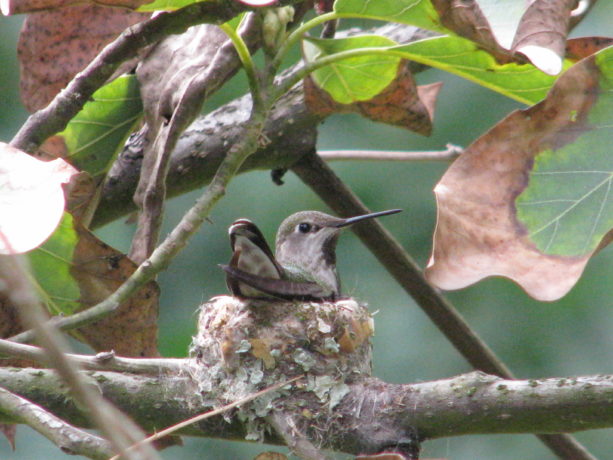
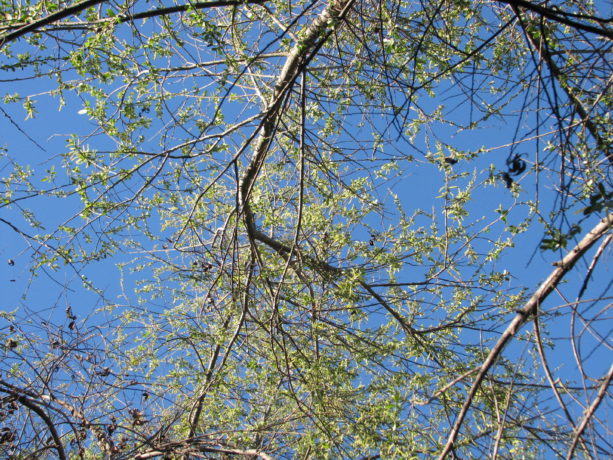
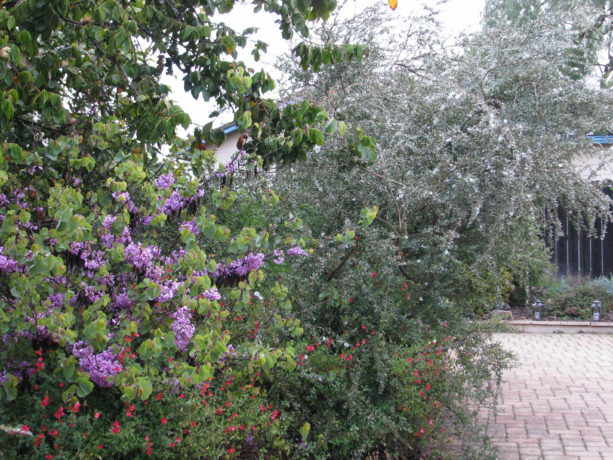
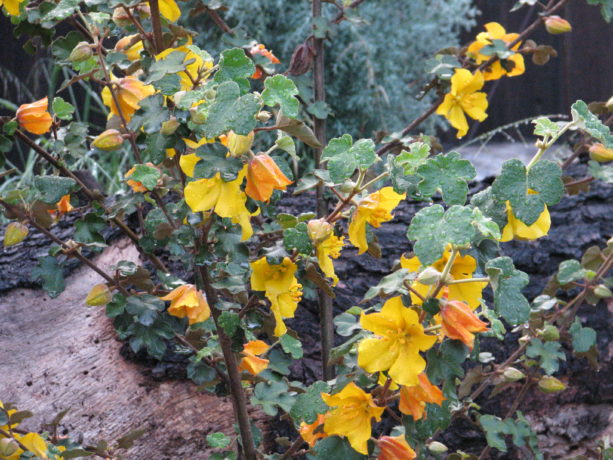
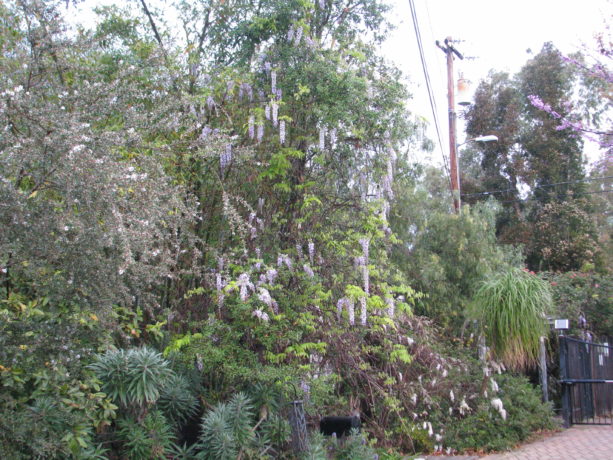
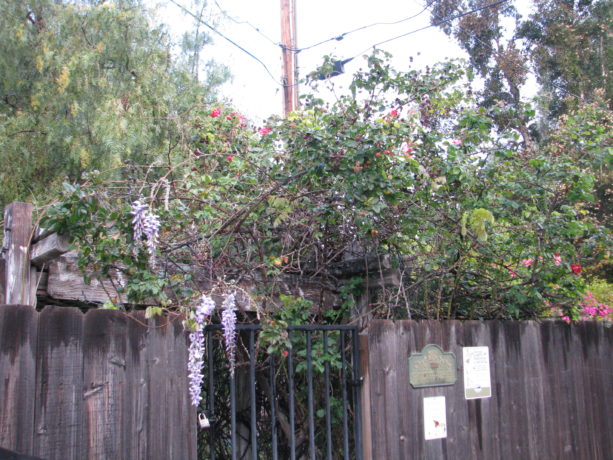
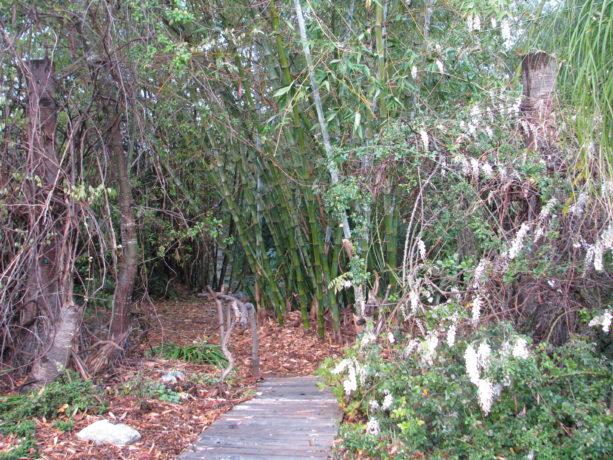
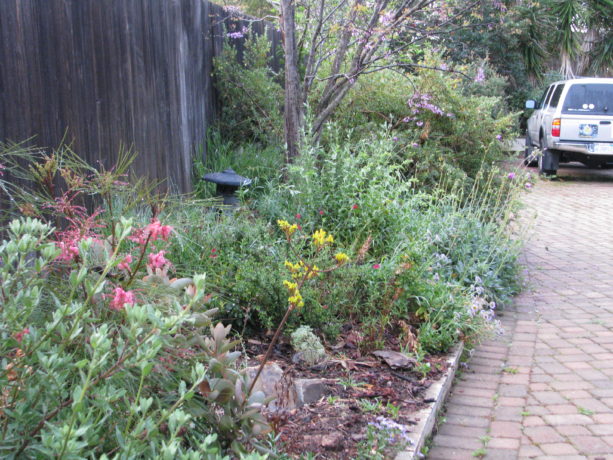
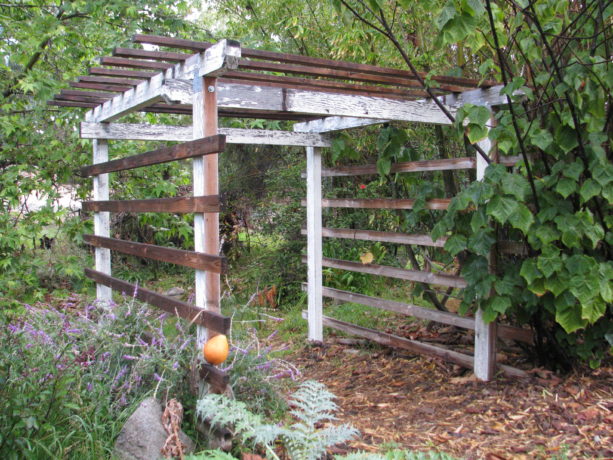
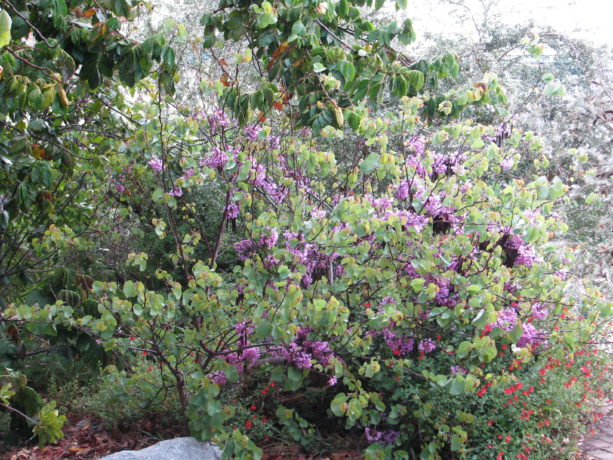
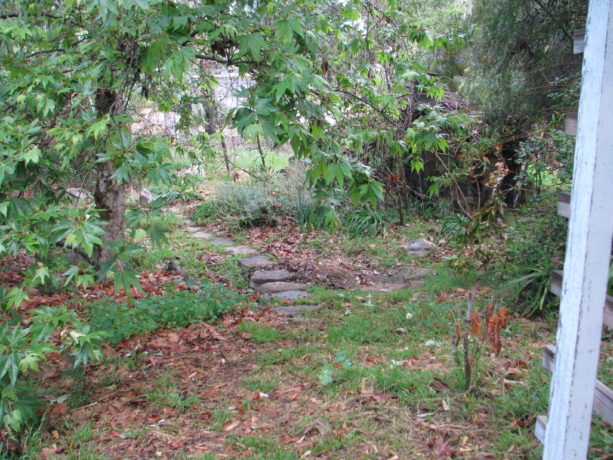

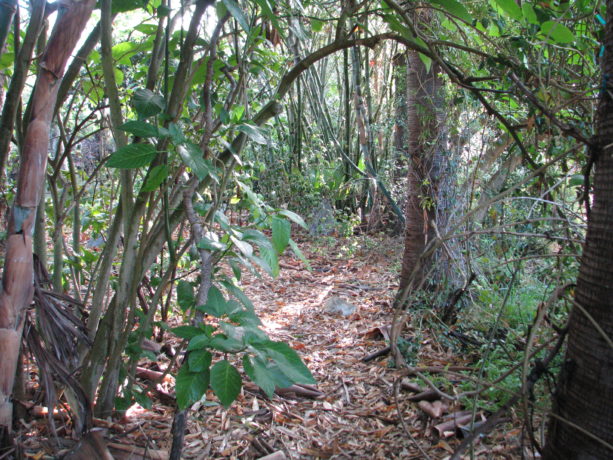
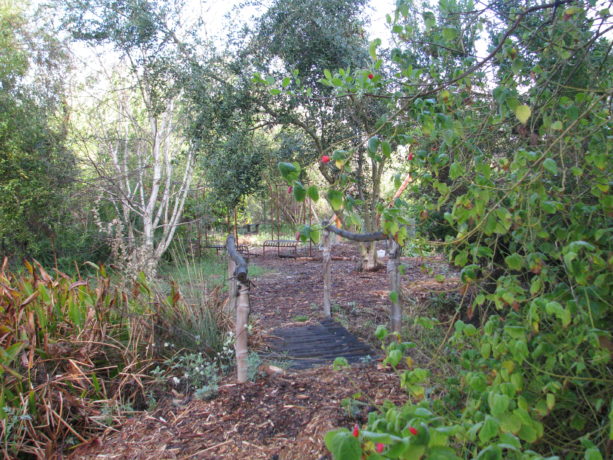
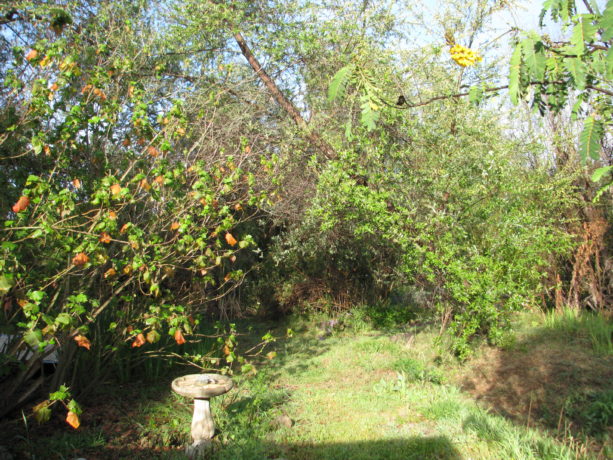
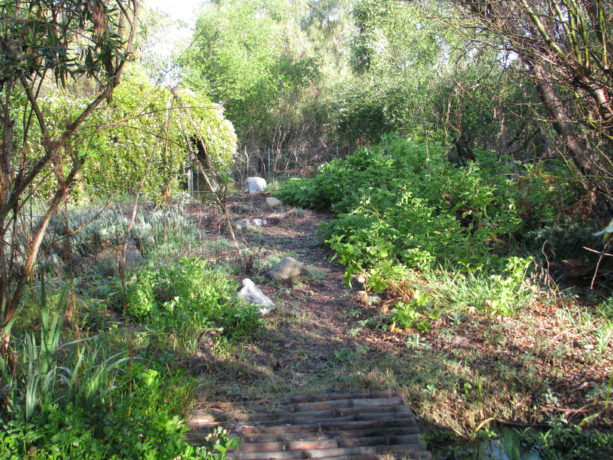
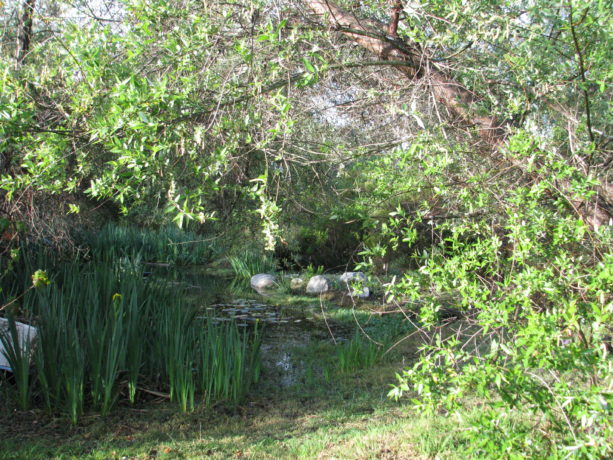
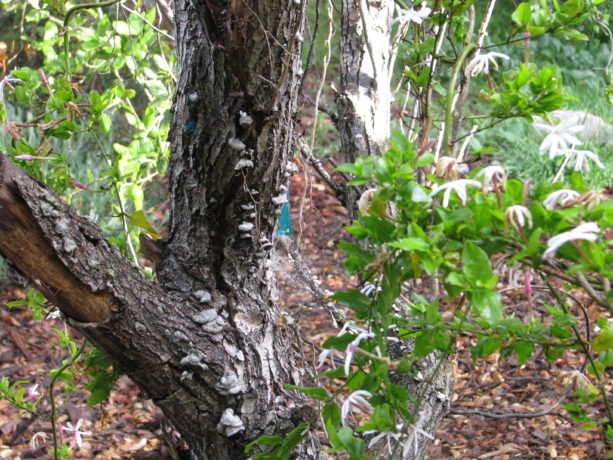
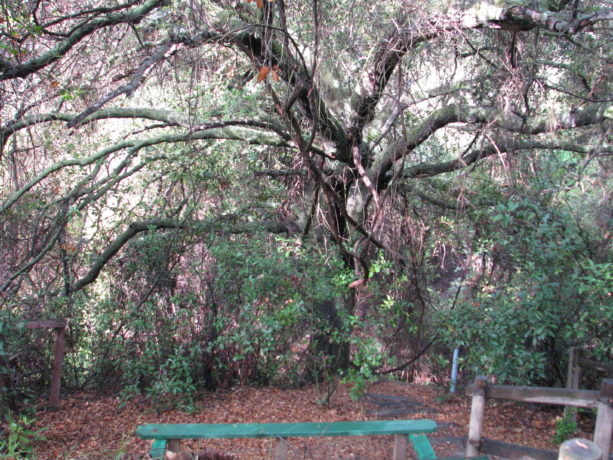
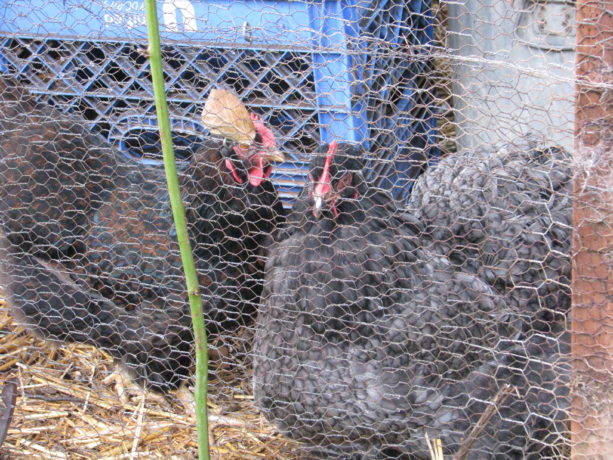
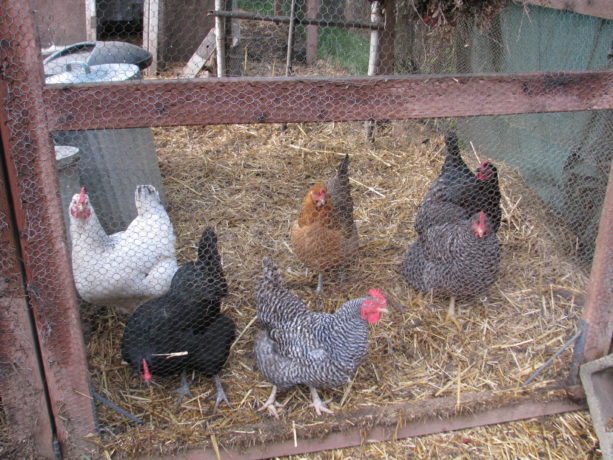
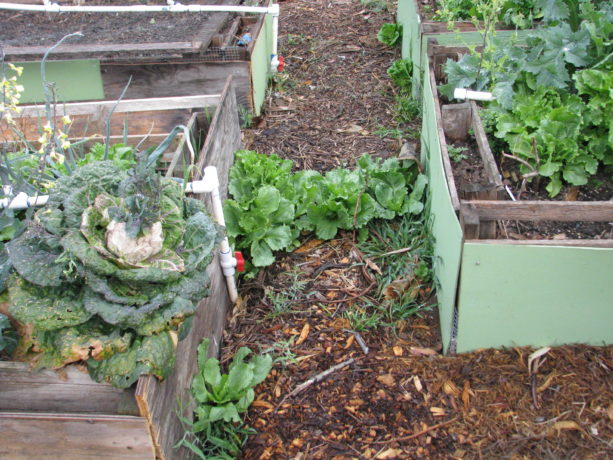
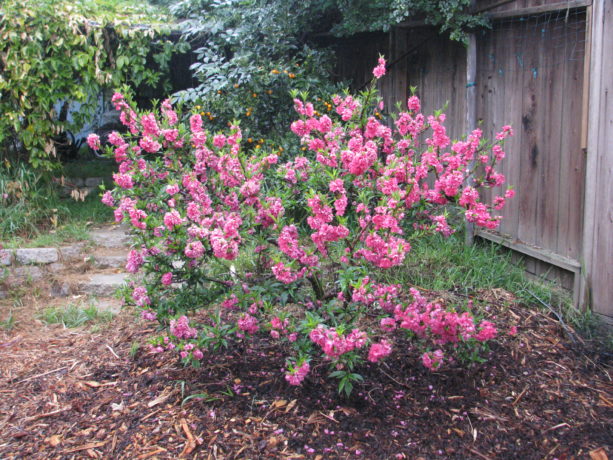
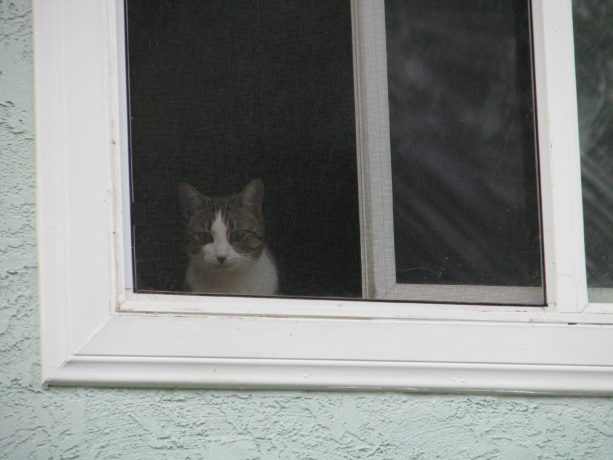
Above from left to right: Momma hummingbird on nest of lichen, arroyo willows leafing out, Western Redbud in full bloom with tea tree blooming behind it, native Flannelbush in glorious yellow bloom, two colors of Chinese Wisteria blooming by the front gate, the main entrance to the garden, the native and Australian planter bed, trellis with last Fall’s pumpkin right where it grew and a perennial artichoke regrowing, another Redbud photo just because, many views of our pathways, majestic Coast Live Oak, our hens including the fabulous Queen Bodacea who is ten years old, last year’s lettuce progeny coming up in abundance between the raised beds, a dwarf peach in full color and McCoy in an upper window, calling to us to come in and rain attention on him. A hummingbird is busy eating insects over our large pond. The pond is unlined and balanced by fish and plants. The yellow flag iris is just beginning to bloom. The foliage on the raft has been flattened by four racoon siblings who love to swim. Birds are singing after an evening rain shower. A perfect Sunday morning in Spring at Finch Frolic Garden Permaculture. (Please forgive the camera noise.) - Animals, Birding, Gardening adventures, Integrated Pest Management, Natives, Planting, Quail, Water Saving
Native Plant List for Birds
Photo by Miranda Kennedy
Today Miranda and I (mostly Miranda!) spoke about native San Diego plants that were best for birds. Miranda’s excellent bird photography and her in depth knowledge of wildlife behavior made our talk for the Audubon San Diego Bird Conference very informative. She is always fun to speak with, too. We presented a slide at the end that listed plants that were featured in the presentation and I promised to post it here. By no means is this an exhaustive list; birds will take advantage of any resources they can to survive. However these plants can be purchased and planted in landscapes (we notably left off the poison oak in the above photo, which is a excellent food and habitat plant, especially for towhees who prefer to nest in it!). And here it is:
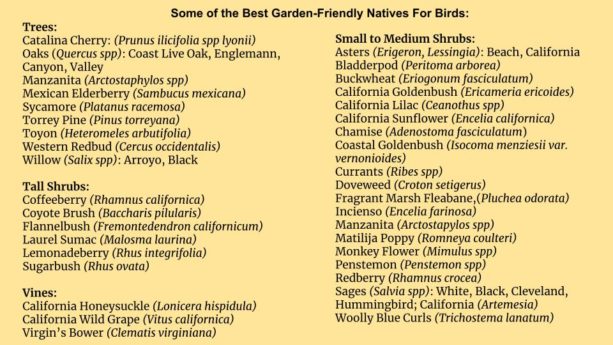
-
Mulch, Don’t Spray!

Foreground has been sprayed with glysophate, and area past the gate has been mulched and planted with succulents. Weeds? Who with land doesn’t have them? If you spray the weeds with chemicals, you kill many weeds and leave the dead evidence to rot away over several months. Any chance of insect or bird food source is gone, and you leave the ground dirt, devoid of life and without protection from the sun or heavy rain. This is a good way to erode the soil. Very ugly, very unnecessary. Many weeds such as Bermuda grass won’t die from one application of chemical. Besides, buying glysophate supports the companies that manufacture and sell it. You can support better companies with your dollars.
If you cover the weeds with newspaper or cardboard and add several inches of mulch on top, you are smothering the weeds, protecting the earth, building soil, starting the food chain, and giving habitat to lizards, birds, insects including butterflies, and frogs. If you have annual weeds, you can just smother them with several inches of mulch. Immediately it looks cool, intentional and natural. The plantings of succulents require little supplemental water and look great. You can also plant native plants to add color, diversity and more wildlife food.
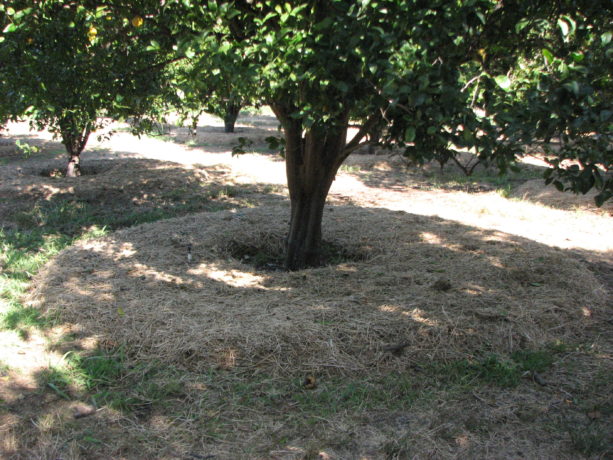
Mulch is not compost, it is what goes on top of the ground to cover and protect the soil. Some mulches can be leaves, bark, straw or wood chips. Free mulch from arborists is an excellent source that keeps valuable natural materials out of the landfill. Compost is soil food that can be added to the soil surface around plants, and used when planting varieties of plants that need a rich soil. You can put mulch over the top of compost to protect it. Mulch can cover an above ground irrigation system.
Tip: if you are using cardboard or thick newspaper around trees, soak the ground and the paper first to lock in moisture. Be sure there is a way for irrigation and rain water to penetrate; you can arrange cardboard like a ceiling fan, so there are spaces between, and mulch over the whole thing. If you are using cardboard in a pathway, soak it first so that it isn’t slippery when stepped on! You do not have to remove tape; it will rise to the top when the glue dissolves and you can pick it up later. Do not use shiny cardboard, but the black ink from paper and most printing is from soy so is very safe to use. Even if its not, a little ink is far better on the soil than spraying with glysophate and leaving bare soil to cook in the sun!
-
Pruning: the basics

A young peach tree volunteer, pruned its first year for height and health. Pruning is a point of contention with me. If you plant a plant in the right place, meaning that it has room enough to grow to its full potential without having to be constantly cut back, then you really won’t have pruning issues. So often I see trees being used as hedges right next to houses or pathways, so they have to be butchered regularly to keep in shape. Because the tree is supposed to be large it produces a lot of woody growth, and over time that is what you’ll see: lots of cut wood with a layer of leaves over the top. Or thorny plants right next to pathways. Or trees with invasive root systems, such as Ficus, California or Brazilian Pepper (neither from California), or eucalyptus, planted right outside a house or near the septic tank. These plants are aggressive in how they find water and they will lift pavement. So understanding the nature of the plant through research, not just what the employee at the garden center has to say, is important so that you aren’t planting an expensive and possibly hazardous problem. If I could wave a magic wand and eliminate 90% of the above-mentioned trees in this state and replace them with drought-tolerant native trees, I’d have no hesitation.
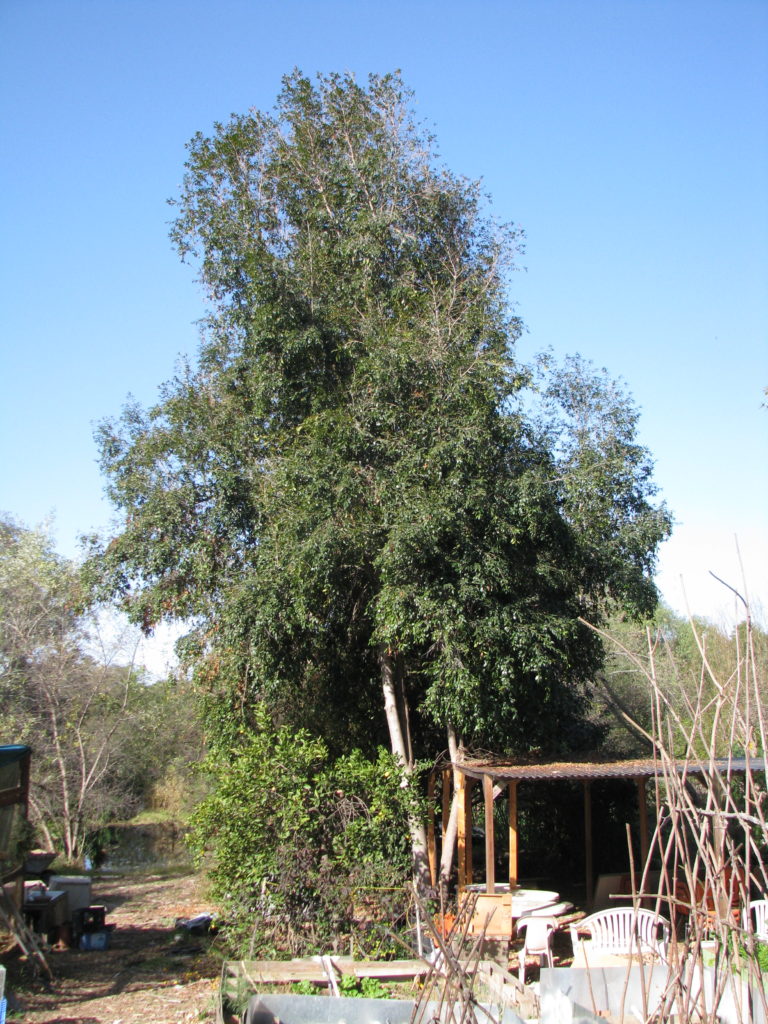
This is eugenia, which has a pretty white flower and red edible berries. I’ve seen this tree planted in multiples between a house and a sidewalk in a 2′ wide planting strip and kept to a 1′ x 3′ square, and planted there by a professional landscaper. Unbelievable. Back to pruning and away from my tree-placement rant.
During my consultations I hear clients say, “This tree needs pruning.” I ask them why they think so, and often they really don’t know. They feel that they have to control the tree somehow, or that human intervention is required. My response is usually, save your money and the preserve the health of the tree by NOT PRUNING. When you make a wound in a plant you open it up for disease and insects. If you continue to change the nature of the tree it will be stressed, and then you will have more insect and disease issues. So please, just leave the trees alone, in most cases.
A horticultural teacher once explained that lawns are partially there for stress control. A person rides through aggressive traffic twice a day, works at a miserable job with miserable people, comes home to messes, a cranky family and bills, has weight issues. So on the weekends he or she can break out the lawnmower and cut that grass down, keep it the same size and make it obey. They have some control over something in their lives, and making that grass immaculate is possibly the only thing standing between them and the loony bin. Over the years from what I’ve seen, I have to agree with that teacher, and extend the example to tree and shrub pruning as well.
When you have young fruit trees, you are planting them for production. You are using them as livestock, so manipulating them for maximum yield is probably on your mind; however, long life and chemical-free growing should also be on your mind, and again, resisting the urge to chop away at your trees is the best bet. Don’t take advice from those in the food-producing industry because they are maximizing their crop for sale using every means they can, including having a short life expectancy for their trees which they will replace at projected intervals. Backyard fruit production is different. You want fruit, but a nice-looking yard as well.
Before you begin, be sure that you have sharp tools that are up for the job. Hand pruners for small stuff, loppers for 1/2″ – 1″, and saws for larger branches. ALWAYS bring Lysol or a bleach solution to clean your blades so that you won’t spread any disease between trees, and treat your blades between each tree. Keep your tools sharp and don’t twist them when cutting or you will mess up your blades. Wear hand, eye, arm, and breathing protection because those little bits have a way of fighting back. For larger limbs, head protection as well. Its better to look like you are ready for a nuclear explosion than to be injured by snapping branches, thorns, falling debris, and even angry insects or birds.
Understand what you are pruning. Many fruit trees and berries fruit on second-year wood, so if you cut it all off, you won’t have blooms. Just because something doesn’t have leaves on it doesn’t mean that its dead; many plants have late dormancy, or go drought dormant in the heat of the summer. If you lightly scratch the bark with your fingernail and there is green underneath, it is alive.
Prune to a node. A node is a growth point. Aim for one that is facing out or to the side, rather than into the plant.
Cut close to the stem, but not right up against it. There is a collar at the base of each shoot, and if you cut just above that, then that will callus over. If you cut into it, it will leave a wound that can be infected. If you leave a stem, that will die back to the node and in doing so may bring in fungus or insects. If you are cutting something heavy, then make an undercut first, then make another cut on top further along the branch, and then the weight of the branch won’t make the bark tear and rip down the tree. Make a final cut close to the collar.
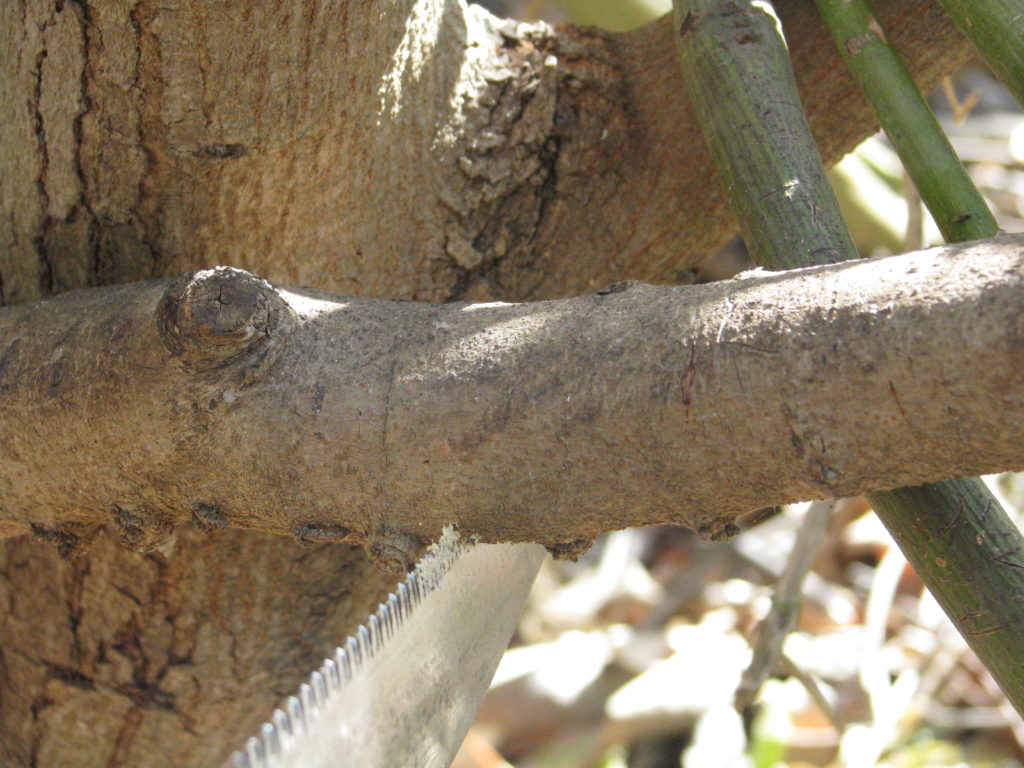
Undercut to prevent the bark from ripping. 
Make the top cut away from the undercut. 
Make the ‘clean up’ cut now that the weight is off, close to the node or collar. Slanted cuts will repel water. The basics for pruning are, for new trees, cut off dead wood. If you have large ornamental trees, you don’t need to do this unless there is disease or insects in the dead wood, or there is a threat of large dead wood falling on someone. Otherwise, don’t feel the need to ‘clean up’ the tree. Most of the insects and fungus that will inhabit that wood are benign, and actually help with the health of the tree and the ecosystem around it.
Cut off diseased wood. If there is a black or brown ooze from a branch, have it identified. It is probably a fungus or an insect. It may be easy to control, but you have to know. Burn, hot compost (150F – 170F), or bag up and throw away that wood so that you aren’t spreading a pathogen.
Cut crossing branches that are rubbing up against each other and will open wounds on the bark. Also, trim some branches that start at one side of the tree and grow through the middle to the other side. They aren’t doing the plant any favors.
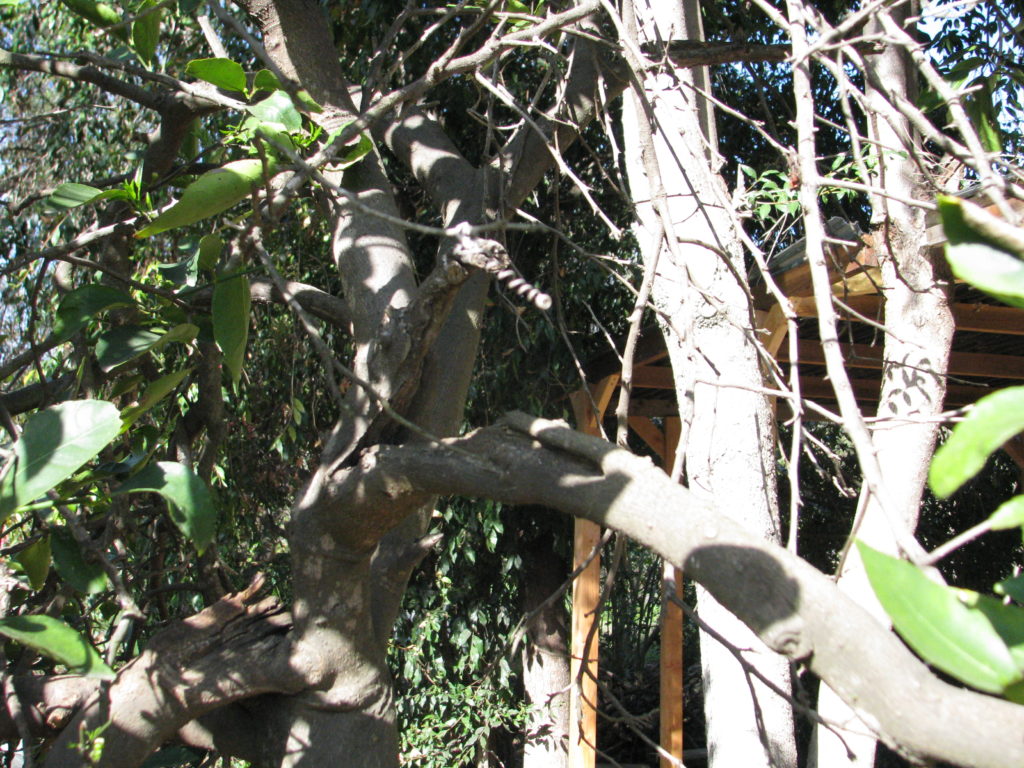
A branch broken and torn from too much fruit weight combined by winds. After you do these quick pruning jobs, usually you have very little to do in the future for maintaining your trees. If you have pine trees, please research the type you have to know if they will regrow at the pruning points or not. So often pines are butchered and they won’t grow back where cut. Or the idea is to ‘give them air’. We have Santa Ana winds, for heaven’s sakes, not muggy conditions that build up fungus like Chicago. Most non-native pines (to S. Ca.) thrive with humidity, so ‘cleaning up’ the pine to allow air flow will just stress them out even further by drying them out. (Also, many pines such as sequoias won’t thrive in S. Ca. because of our alkaline soil and alkaline water. They will live for awhile, and then their root base just can’t feed the growing top of the tree which is supposed to be huge due to the inability to obtain the nutrients they require from our non-acidic soil conditions.)
Many people prune their fruit trees down for height so that you can pick them. This should be done within the first two years after planting a tree so that its hardwood forms low, and then the greenwood sprouts can be pruned yearly to keep it low. Again, if you plant a dwarf or semi-dwarf tree, then you won’t need to stress out the tree every year.
When you stress a plant, just like when you yourself become stressed, you will have to treat it. Usually people resort to a series of chemicals, each of which incur more issues that will need to be treated with more chemicals. If you stress a tree and it is covered with insects you then spray those insects, which then also kills off all the hundreds of native preditory insects, so that you will have more bad insect and disease issues in the future. The best policy is to plant the right plant in the right place (permaculture is 99% design, remember), understand the needs of the particular plant and meet them, do any corrective pruning at the beginning (they are children and need gentle correction to help them grow strong!), and then provide them with appropriate soil and appropriate water from then on. No chemical sprays! No systemics! No tree torture! Less stress for the plants, and less stress and expense for you.
If you feel the urge to prune, take up adult coloring books or yarn dying, labyrinth walking or birdhouse building instead until the urge passes. When you really don’t feel like pruning then you can logically evaluate your tree’s needs and won’t hack away at it. Its like not shopping while hungry. Enjoy the healthy beauty of your plants and the nature they support instead.
-
Habits I’ll Keep Post COVID-19
At our house we already repurpose and recycle, and mend as much as we can. The COVID-19 pandemic made us wonder about supply availability, food security, and even more about our footprint on this planet. As we live in a fire zone, and with the longer, hotter summers and drought the thought of burning is always with us now. Fire season is everyday, not just in the fall. Although if we and our animals were safe it would be enough, the idea of losing the possessions which are touchstones with loved ones hurts. I’m not one to just take a photo of a thing and then give the item away; I rarely take time to look at photos, and seeing the small clay pots, paintings, books and kitchenware on a daily basis links me with loved ones past and elsewhere. So in 2010 we began some habits which we will continue, most of them started by my marvelous daughter, Miranda. Here is a short list:
- Washing and reusing plastic bags. We’ve been doing this for years on a smaller scale, but I wasn’t as diligent about single-use plastic bags when they came my way. Now we also wash and dry any aluminum foil, single-use bags and plastic cling-wrap. We try not to accumulate plastic, but we have frozen a lot of harvests and as we use the supply the bags become available again. Unfortunately the pandemic postponed the new practice in CA of bringing your own bags for groceries; instead of accumulating more I put my supplies back into the cart and bag them in the parking lot.

2. Folded napkins. We stopped using paper napkins at mealtime and shifted to using cloth. My daughter began folding them using a book and the Internet as guides. Every meal feels posh now, and the idea of having to wash them makes me a more careful eater! Why not celebrate every meal?
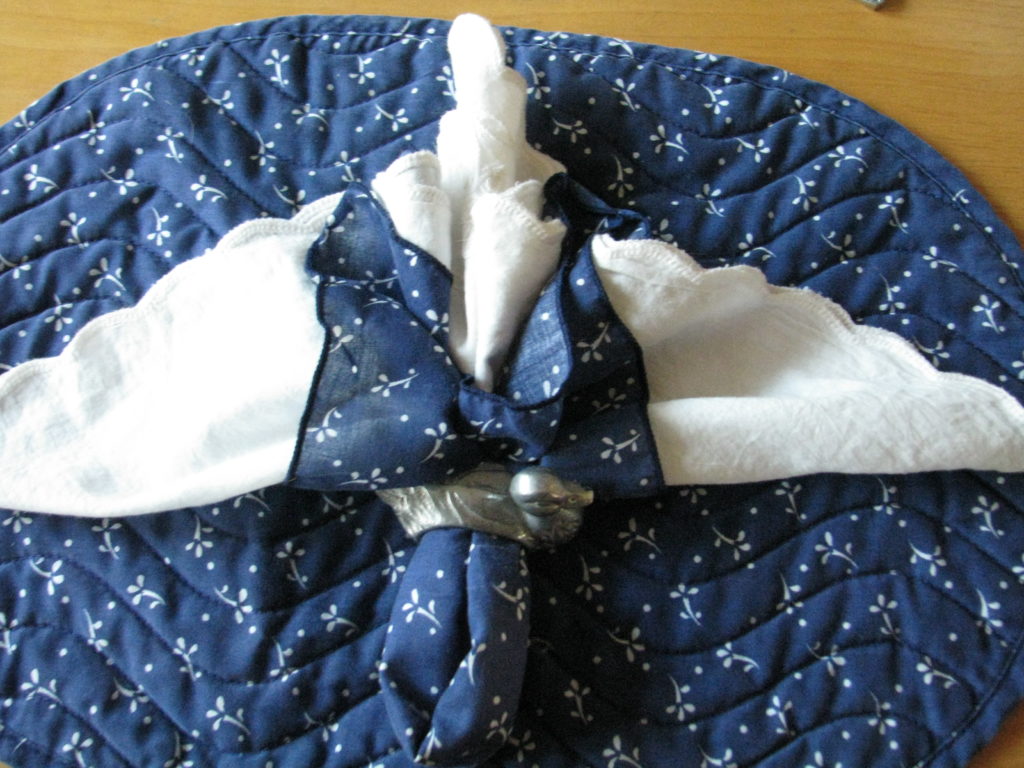
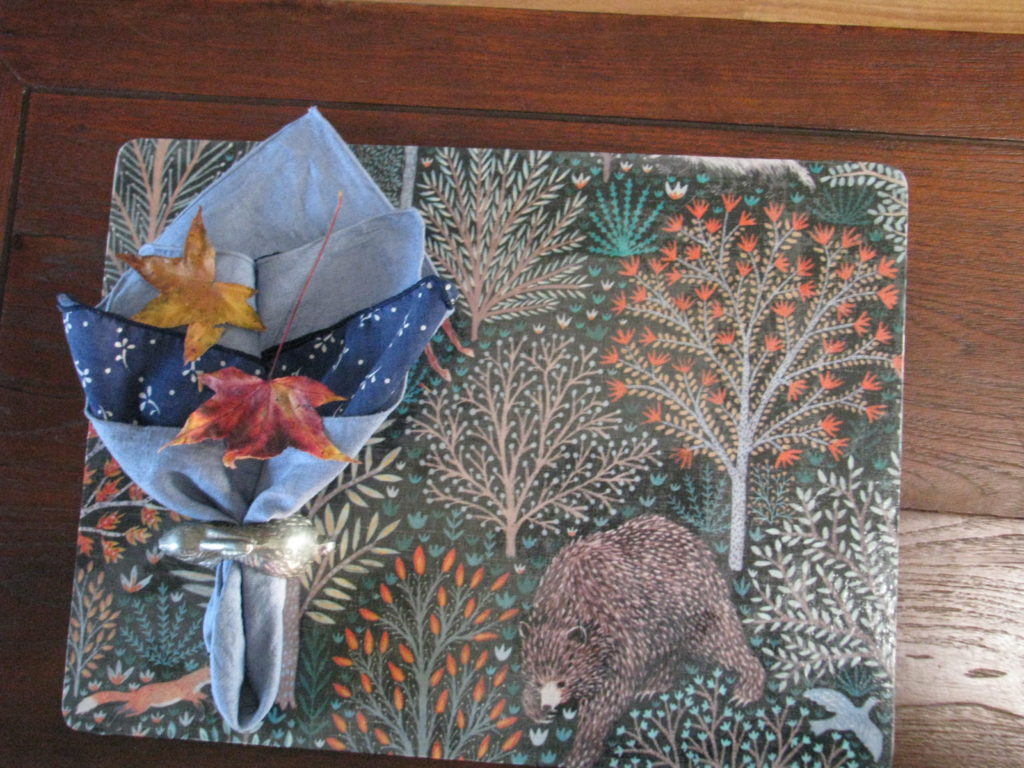
Miranda made the placemats with fabric laminated with an iron. They are on cardboard backing. 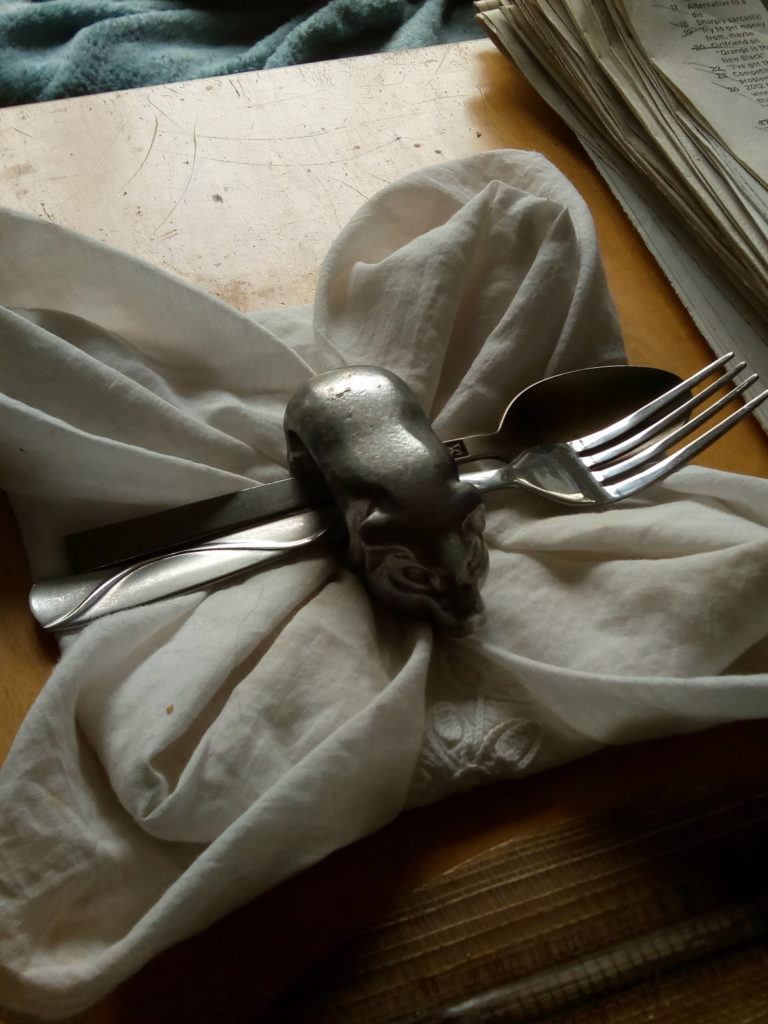
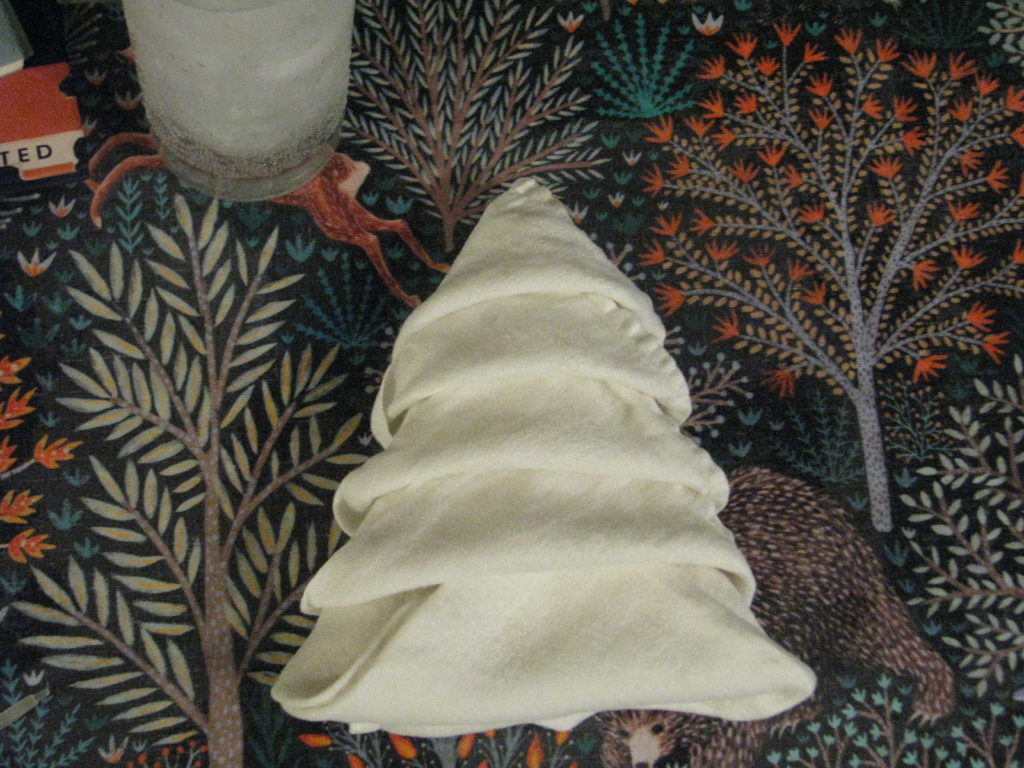
3. Using the good stuff. My parents worked their way up from absolutely nothing. When I was in elementary school my mother went back to formal work as a manager in the new May Company department store in Carlsbad. She ran thirteen departments, and I spent many a sick day sorting yarn in the stockroom. She used her discount to buy beautiful things, including glassware. My parents loved entertaining; my mother would make everything including homemade baguettes, and serve drinks in lovely glasses. I inherited most of the glassware, where it languishes in my cabinets. I don’t entertain often, and when I do it is mostly informal. Miranda started a tradition of serving our morning juice in fancy glasses. She squeezes orange juice and grapefruit juice. We have a shot of grapefruit juice and a little more of the orange juice, which makes the use of shot glasses, tiny beer steins, champagne flutes and cocktail glasses so much fun. Its a little like having my parents at the table again, and I’m sure my mom would be so happy to see the glasses being used.

4. Soaking in appreciation. Every moment is transient, and to make it last I must recognize it before it becomes the past. More than ever I work on changing the negatives and the fear in my thoughts. Deep breath in, deep breath out. If fire burns everything we have to ash, if I lose my ability to earn an income due to illness, injury or age and our lives change drastically economically, if even more tragedy comes to our doorstep, having lost so many friends these last years and suffering along with their families, I have this moment right now to appreciate. Right this moment I am okay. I have food, water and shelter, which is beyond what so many people have. Beyond that, its all cake. Health, loved ones, income, safety… all cake. Complaining about what I have or can’t have is as much of a sin as any other. So I try hard to have quiet appreciation of my life. It can’t be made ‘better’ with additions or subtractions, it can only change. Whether that change is ‘good’ or ‘bad’ is purely opinion. Deep breath in, deep breath out. This goes a long way towards helping deal with the stress that has been raining from the skies instead of water this past year. Being appreciative when grieving, when hurting, when overwhelmed is a much more challenging task. Shaking my fists at the sky raging at the unfairness and injustice helps just a little, but if I hold onto the emotion I become ill. Deep breath in, deep breath out. Soak my soul with appreciation. So much cake.

Gifts from friends, furniture that was my parent’s, a table that was free and temporary twenty years ago, prunings from our stonefruit trees about to burst into bloom, the early January sunset. All cake, and much appreciated. -
August at Finch Frolic

Black Beauty zucchini. This year Finch Frolic has been particularly beautiful. Of course, this year we had to close down throughout the spring. Fortunately we’ve been able to reopen for limited-capacity tours with safeties in place. However, I really miss sharing how lovely the garden is, and I want to let you have a little tour right in your home.

Little Marvel Popcorn. It tastes so good! These photos were taken this morning before the temperature rose; its in the 90’sF here today, in North San Diego County. I apologize for the phone camera, as my good camera is in for repair. I only wish that you could also smell the moist mulch from the light overnight dew, or hear the clug-clug of the crow, the tittering of a flock of bushtits and the scuttling of lizards through leaves, which I experienced as I walked around the garden. All of these friends and so many hundreds more are working the garden today and every day, keeping it in balance.

A blue dasher dragonfly, one of many species that patrol for insects all over our property. Their larvae in our ponds look like little dragons, and they eat mosquito larvae as well. Watercress behind. Our food forest is a low-water-use garden, on poor soil, using no additives to the ground other than occasional compost. There are no herbicides, pesticides or other factory-made chemicals used here, and there are two of us who care for the garden. Most of the seasonal beauty this year is due to the diligence of my daughter Miranda who took seed sprouting to a whole new level even before the pandemic arrived. We rely heavily on the insects, birds, lizards, frogs, soil and water microbes and creatures to do all the work protecting the plants, and the plants themselves to create good soil. All we add is a low dose of salty well water which the humus cleans, and leaves or sheet mulch on top. Our fruit trees receive a dose of blender compost once in awhile. Miranda and I hope that these photos bring you peace and lift your spirits, and that knowing you are looking at a safe habitat that is thriving with life gives you a feeling of security as well. It can be done. Permaculture must be done. Best of health! Diane

From the driveway looking down the main pathway into the garden. 
Lorenziana Gaillardia, to feed the pollinators. 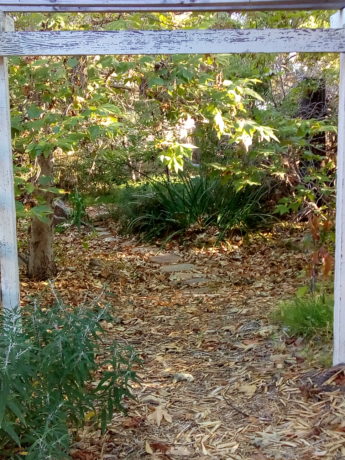
Rock steps cross the large rain catchment basin. Sycamore leaves protect the soil from the heat. 
Our new orchard, with beans trained up a teepee over a fruit tree, and tomato cages behind. 
Our old Ca. Live Oak. Oaks are home to over 300 species of bird and insect. 
Our jasmine-covered gate in the sun. 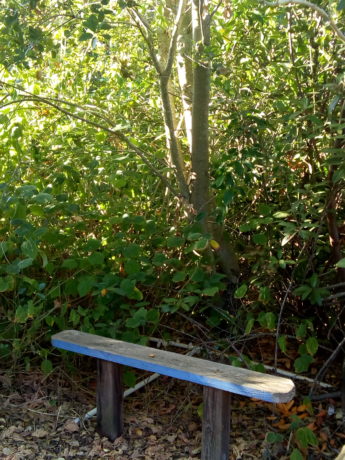
Resting place, made from recycled wood. 
Figs! Panache Striped Tiger. 
Dawn through the birch trees, with Naked Lady amaryllis blooming behind the blackberries. 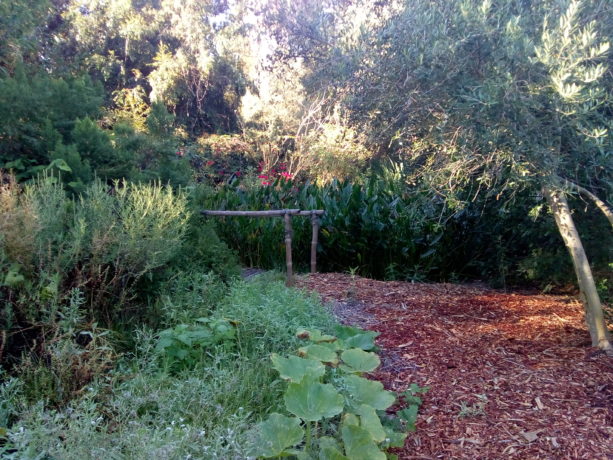
Our small bamboo bridge next to our little pond. 
Dawn through an olive tree. 
A native mallow wildly blooming over a bamboo footbridge Miranda just built. 
Black Krim. 
A plant guild combines plants with different functions for the benefit of all. 
The Torch Tithonia is over 5′ tall, and butterflies and birds love it. A plum, squash and orange tree in the foreground. 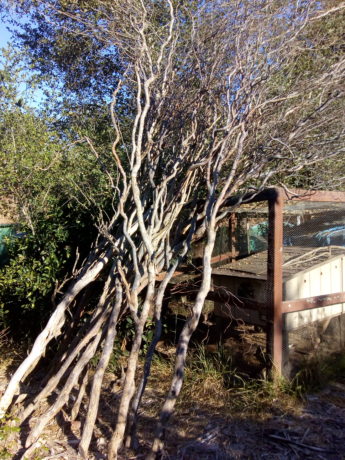
We pollarded our willow trellis in January, and these tall interesting limbs are waiting for some creative project to arise. 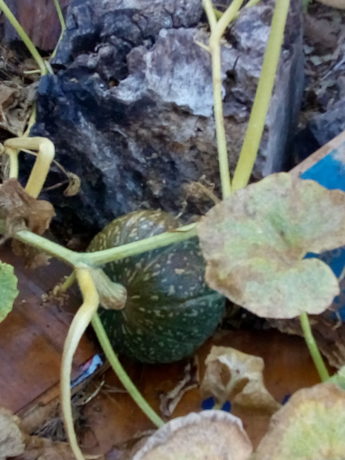
Kabocha squash. 
An army worm taking a sleep in a mallow flower. 
We grow the timber bamboo, and eat it, too! 
This beauty is a carrot, Lunar White, allowed to go to seed. Gorgeous and great food for our tiny native insects. 
Lorenziana Gaillardia. 
Straw flower and carrot. 
Apples do very well in hot weather. Cripps Two. 
Red Kuri squash vine past the seating. 
A whole mess of Naked Ladies! 
Tall Double Mix strawflowers, (Helichrysum bracteatum). 
The Withy Hide, or willow hut. 
Hard to believe that these massive trees grew so quickly. It has everything to do with water capture in the soil. 
This stump has personality! Brachychiton rupestris, Australian Bottle Tree. 
The leaf cover makes this rain catchment basin look full. 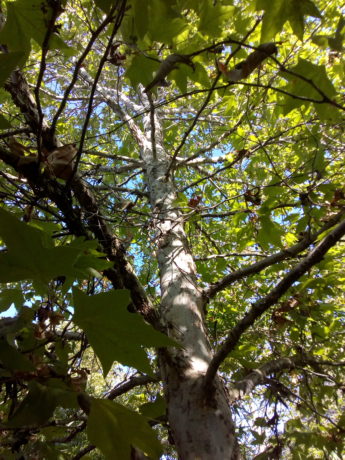
California sycamore, 8 years old. 
A covered bridge over the rain catchment system. 


